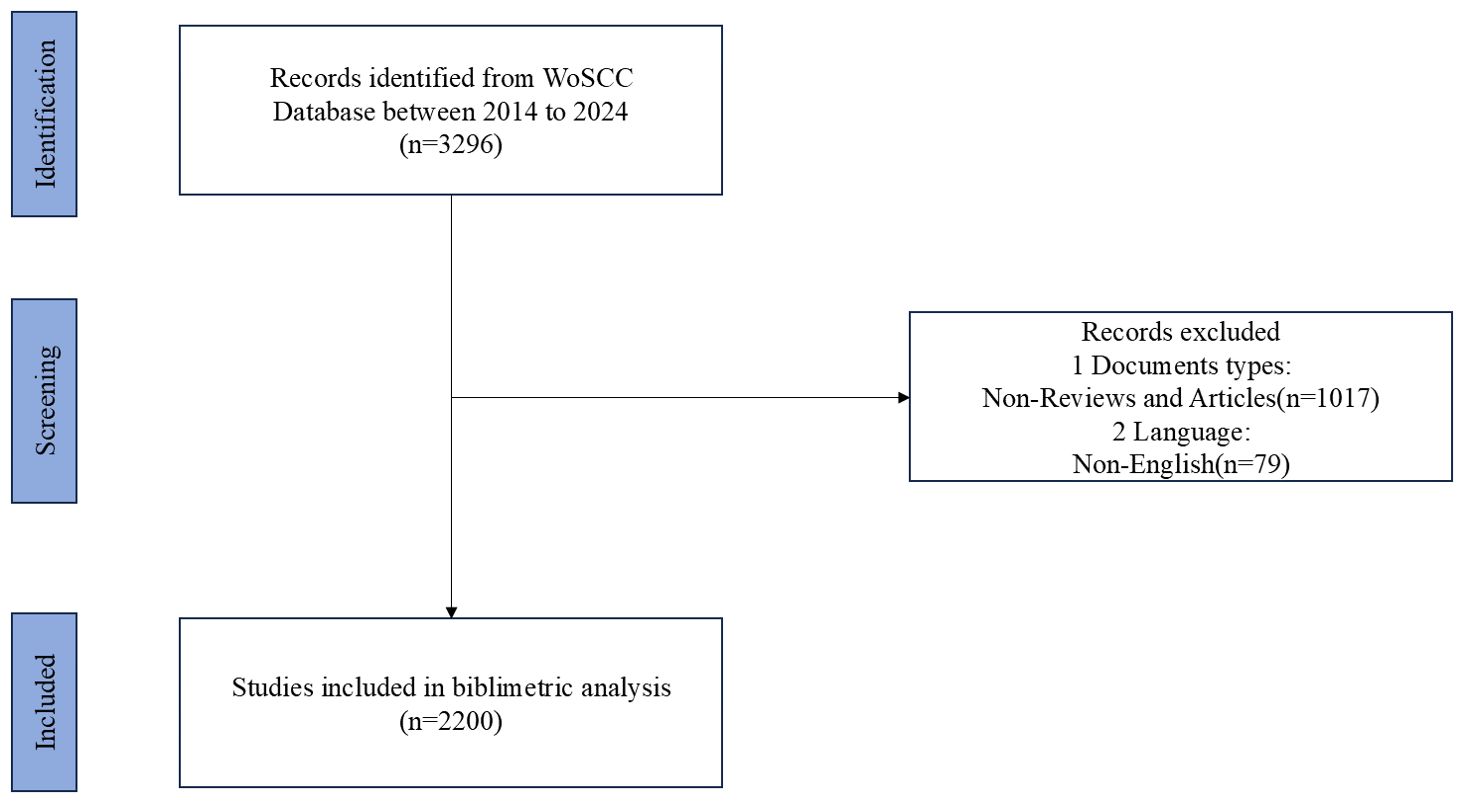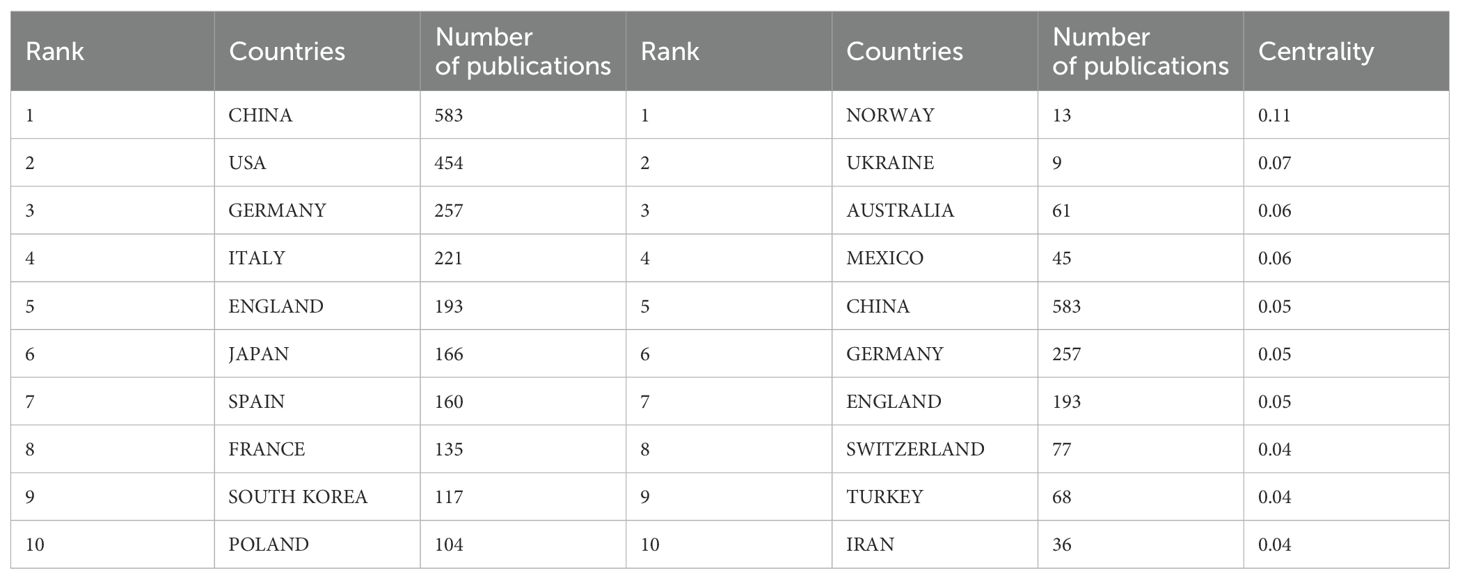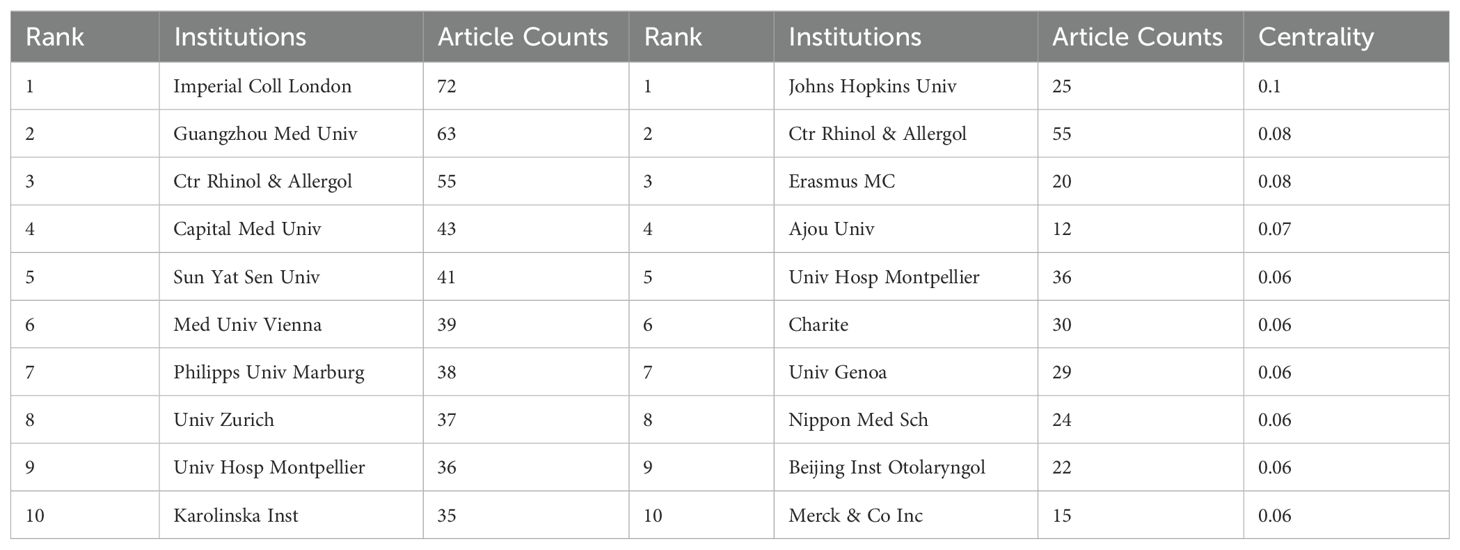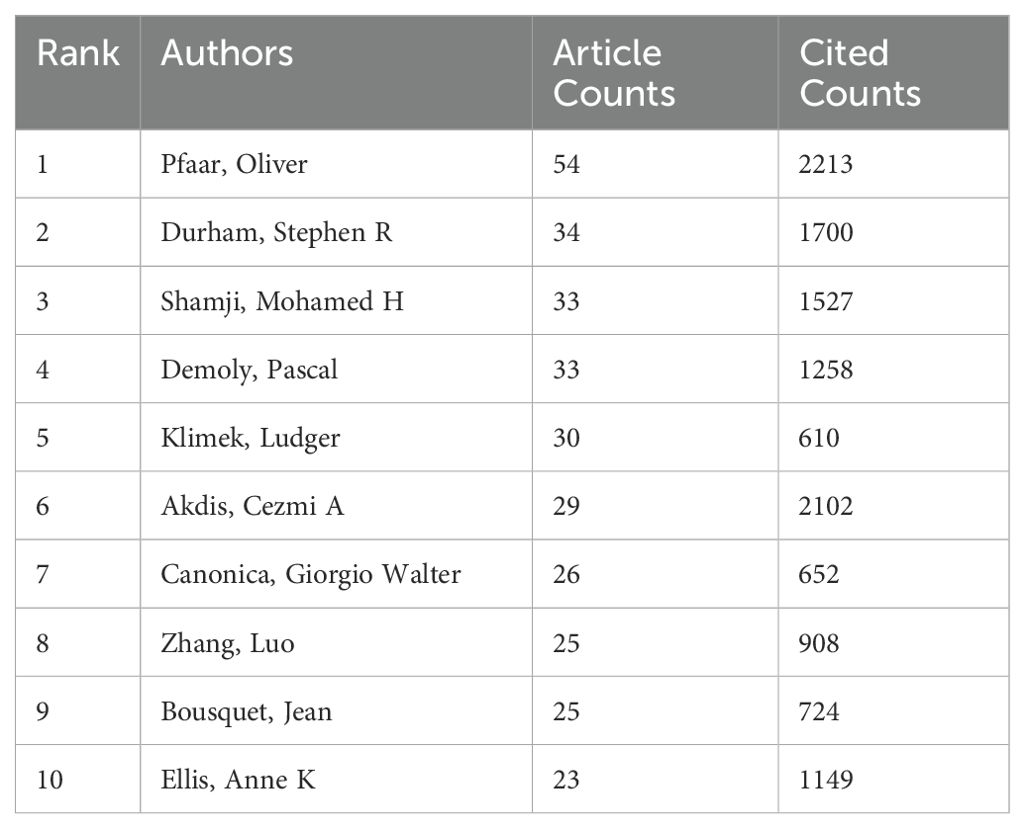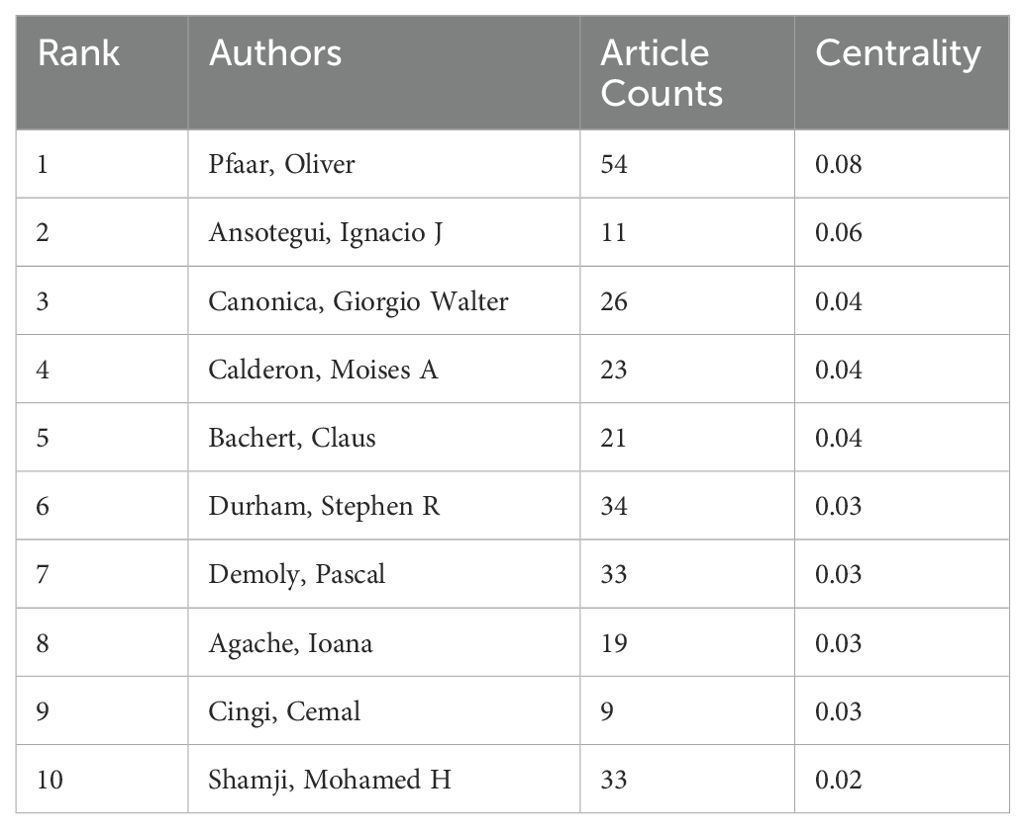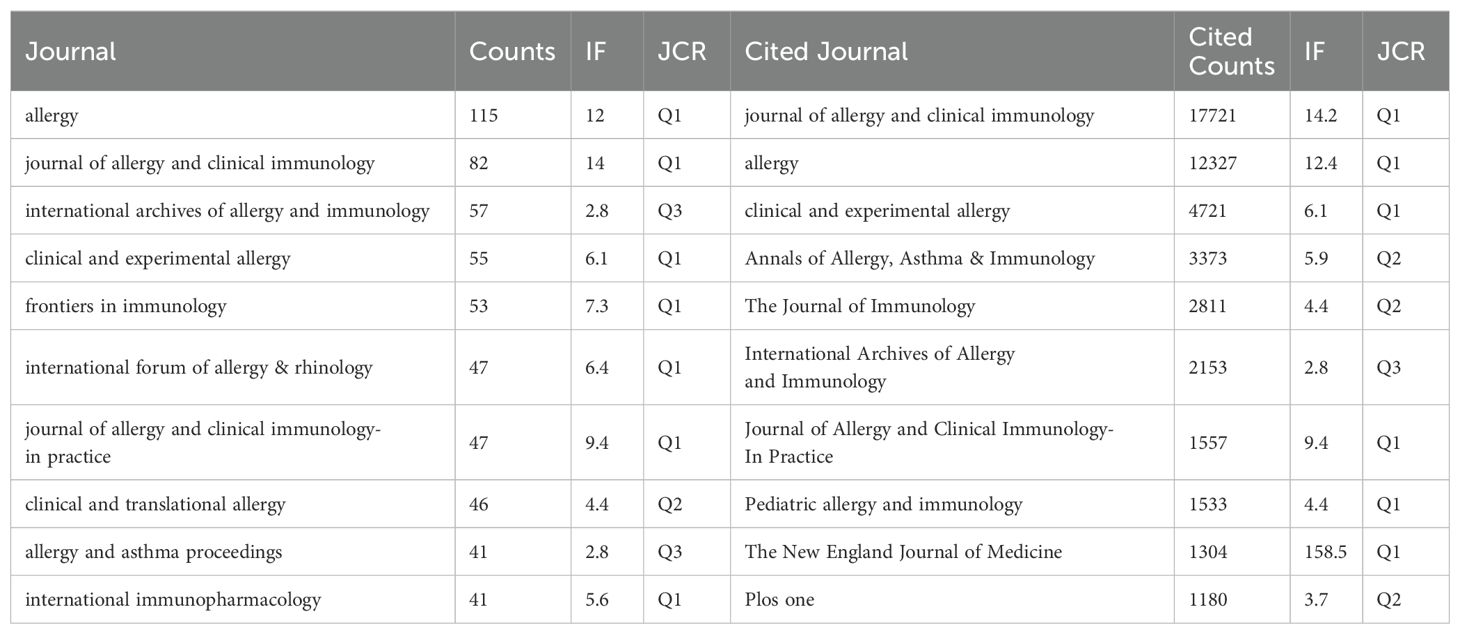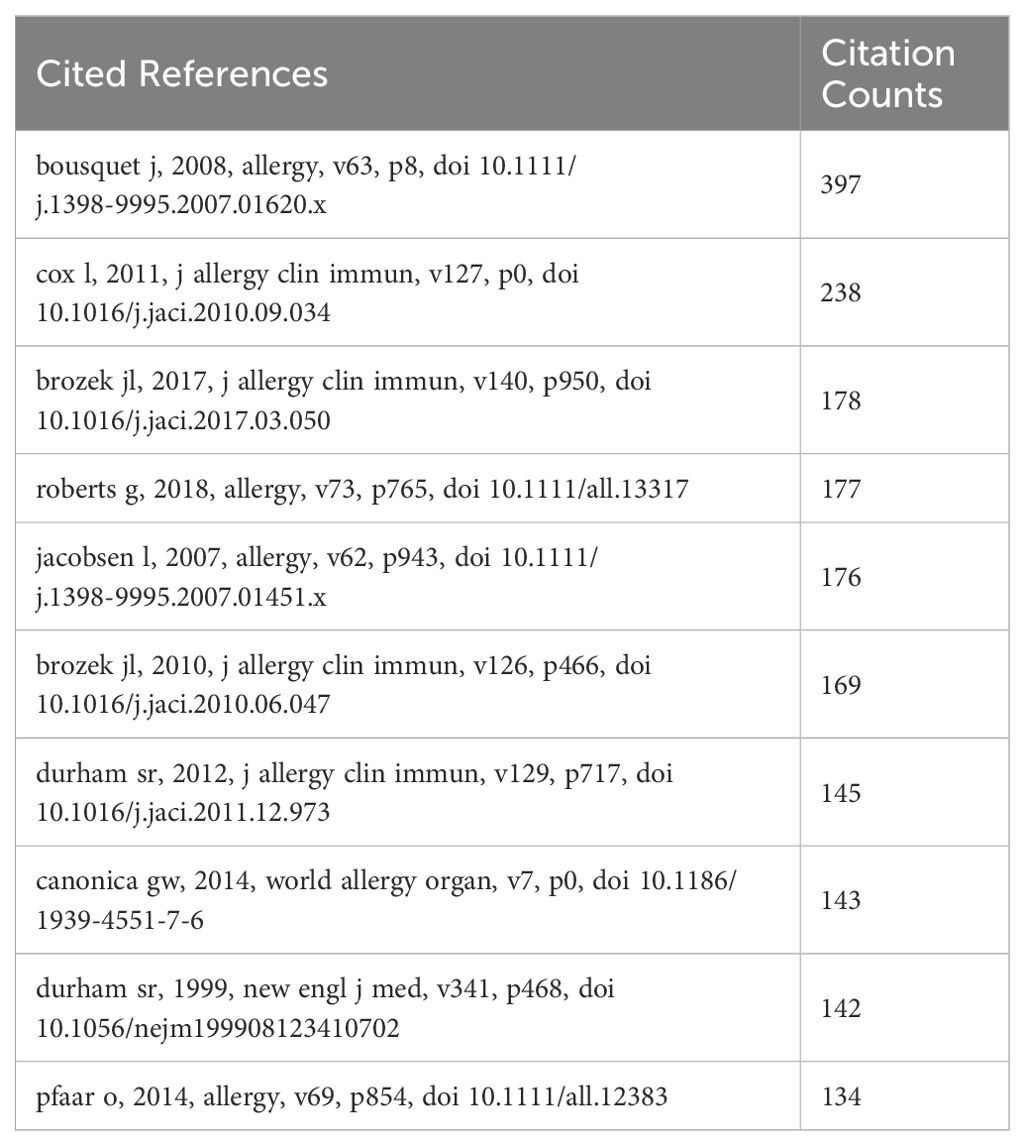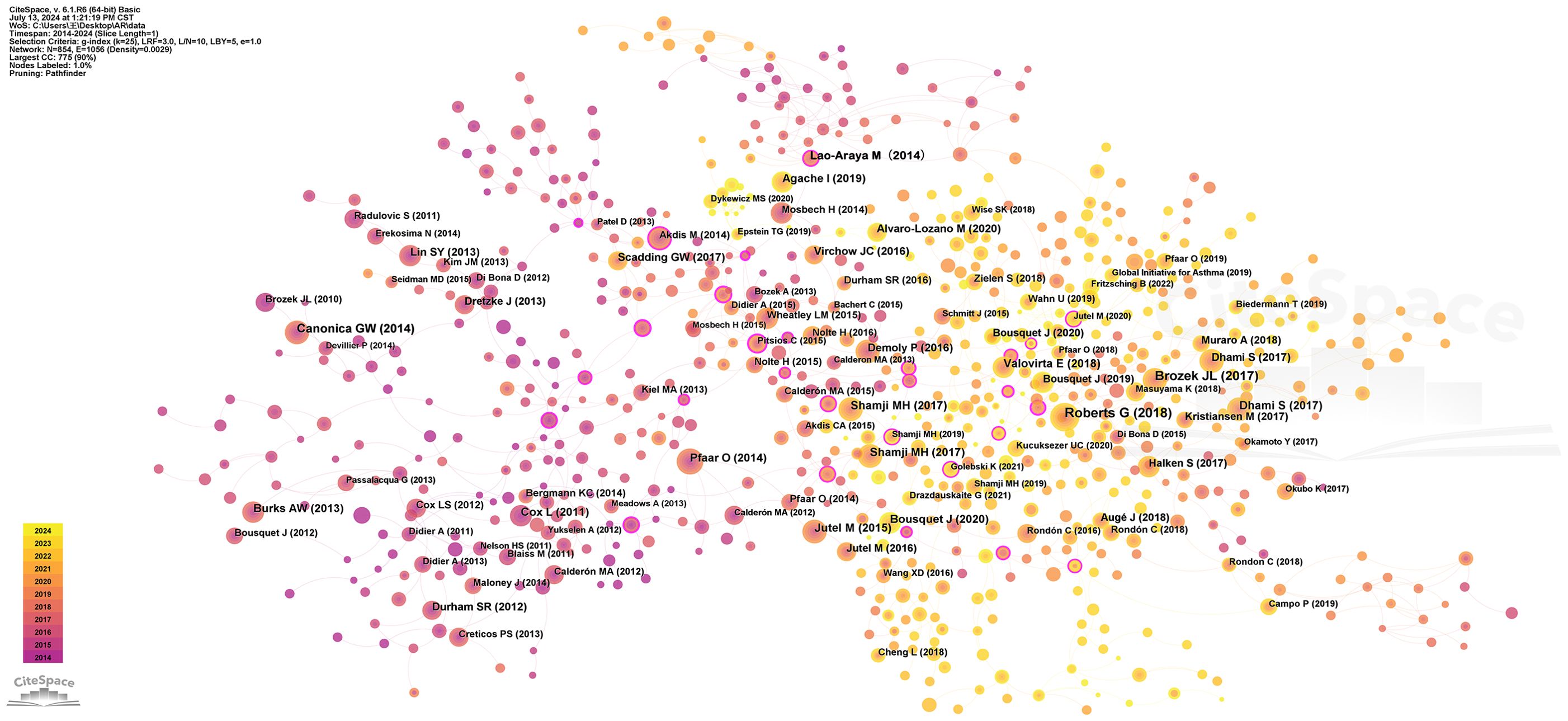- 1Department of Otolaryngology, Huaihe Hospital, Henan University, Kaifeng, China
- 2Translational Medical Center of Huaihe Hospital, Henan University, Kaifeng, China
Background: This study aims to provide a comprehensive bibliometric analysis of research trends, hotspots, and future directions in the immunoregulatory mechanisms of allergic rhinitis (AR) from 2014 to 2024.
Methods: Data were sourced from the Web of Science Core Collection (WoSCC), covering articles and reviews published between April 1, 2014, and March 31, 2024. The search terms included “Allergic Rhinitis,” “AR,” and related terms along with specific keywords related to immune cells and inflammatory mediators. Bibliometric tools such as CiteSpace, VOSviewer, and SCImago Graphica were used to analyze institutional cooperation networks, keyword co-occurrence, citation bursts, and research topic evolution. Microsoft Excel 2019 was employed to display annual publication trends.
Results: A total of 2200 papers met the inclusion and exclusion criteria. The number of publications showed an upward trend over the past decade, with a significant peak in 2021. China (583 papers) and the United States (454 papers) were the major contributing countries. Imperial College London emerged as the leading institution. Key research frontiers identified include the roles of NF kappa B and air pollution in AR. Keyword burst analysis revealed emerging topics such as respiratory allergy and personalized treatment strategies. Notable limitations include the exclusive use of the WoSCC database and the restriction to English-language publications.
Conclusion: The field of immunoregulatory mechanisms in allergic rhinitis has seen significant growth, with China and the United States leading the research. Future research should focus on developing personalized treatment plans and understanding the comprehensive impact of environmental factors. Continued interdisciplinary collaboration and international cooperation will be essential for advancing therapeutic strategies in AR.
1 Introduction
Allergic rhinitis (AR) is a prevalent chronic inflammatory condition affecting over 500 million individuals globally (1). The incidence of AR is notably higher in industrialized nations (2), with some countries reporting prevalence rates as high as 50% (1). Moreover, urbanization and industrialization have contributed to a rise in AR prevalence in developing countries, with the self-reported prevalence of pollen-induced allergic rhinitis (PiAR) in the grassland regions of Northern China reaches a remarkably high rate of 32.4% (3). The high incidence of AR imposes a substantial burden on overall health and has significant financial implications due to both direct and indirect costs associated with disease management. A recent study in the Netherlands estimated the total cost of AR to be €4,827 patient/year (4).
The pathogenesis of allergic rhinitis (AR) begins with the sensitization phase, where initial exposure to allergens such as pollen or dust mites induces the production of allergen-specific immunoglobulin E (IgE) (5). These IgE molecules bind to receptors on mast cells and basophils. Upon re-exposure to the same allergen, the IgE antibodies cross-link, triggering these cells to degranulate and release a cascade of inflammatory mediators, including histamines, leukotrienes, and cytokines. This process results in the characteristic symptoms of AR, such as nasal congestion, sneezing, itching, and rhinorrhea, and constitutes an immediate hypersensitivity reaction, also known as a Type I allergic reaction (6). The rising prevalence of AR and other allergic diseases is attributed to environmental changes and lifestyle factors that affect immune regulation, leading to an increased susceptibility to allergic sensitization and chronic inflammation (7). Understanding these mechanisms is crucial for developing effective therapeutic strategies (8, 9).
Given the increasing prevalence and impact of AR, studying its immunoregulatory mechanisms is of paramount importance. Understanding these mechanisms can lead to the development of more effective and personalized treatment strategies, thereby improving patient outcomes and reducing the economic burden associated with the disease (10–12).
Current treatments for AR, such as pharmacotherapy (13) and allergen-specific immunotherapy (AIT) (14), offer symptom relief to some extent, but they are not perfect (15, 16). These approaches face challenges including potential adverse reactions, variability in individual patient responses, issues with long-term treatment adherence, and economic burden (17, 18). Given these limitations, it is crucial to delve deeper into the immunoregulatory mechanisms of AR. Such research not only aids in developing new therapeutic strategies but also enables more precise personalized treatments, improves efficacy and safety, and helps prevent further disease progression.
To better understand the developments in this field, we have chosen to conduct a bibliometric analysis covering the period from 2014 to 2024. This ten-year analysis aims to capture and evaluate the evolution of research, revealing major trends and patterns in the field. This period has witnessed significant advancements in immunology and allergy research, allowing us to comprehensively outline the trajectory of research developments and shifts in focus within the scientific community. To the best of our knowledge, this is the first study to utilize bibliometrics and visual analysis to investigate trends in immune regulation mechanisms of allergic diseases.
2 Methods
2.1 Data collection
Data for this study were sourced from the Web of Science Core Collection (WoSCC), a widely used citation database covering various academic research fields. To ensure data completeness and accuracy, the retrieval date was set as April 14, 2024. The search terms included “Allergic Rhinitis” or “AR” and related terms, along with specific keywords related to immune cells and inflammatory mediators. The search terms “(Allergic Rhinitis OR AR OR Rhinitis Allergic OR Allergic Rhinitides OR Rhinitides Allergic),” “(Immune Regulation OR Immune Cells OR Immunotherapy),” and “(Mast Cells OR Eosinophils OR T Lymphocytes OR Cytokines OR Interleukin OR Histamine OR IgE OR Allergens OR Inflammatory Mediators)” were used. The time range was set from April 1, 2014, to March 31, 2024, with language restricted to English and only including articles and reviews. Figure 1 illustrates the literature search and screening process for this study.
2.2 Search strategy
The search strategy involved a comprehensive and systematic approach to identify relevant literature. Specific inclusion criteria were set to ensure the relevance of the selected articles: (1) studies focused on allergic rhinitis and its immunoregulatory mechanisms, (2) articles and reviews published in peer-reviewed journals, and (3) publications in English. Exclusion criteria included: (1) non-research articles such as editorials, letters, and conference abstracts, (2) studies not directly related to allergic rhinitis or its immunoregulatory mechanisms, and (3) duplicate records. This rigorous approach ensured that only pertinent studies were included in the analysis.
2.3 Data screening
After the initial data collection, literature screening was manually conducted by two independent researchers, Yandan Wang and Liangran Zhang, to ensure that relevant studies were selected based on predefined inclusion and exclusion criteria. Aside from the initial data collection phase, this process did not involve automated algorithms or specific screening programs. In the initial phase, bibliometric tools were used to retrieve relevant studies from databases. The manual screening process ensured the accuracy and consistency of the final dataset. Disagreements between researchers were resolved through discussion or consultation with domain experts such as Junpeng Luo and Baoyuan Shi. This dual screening approach effectively enhanced the accuracy and reliability of the data.
2.4 Data analysis
Bibliographic records were exported and saved in both “Full Record and Cited Reference” and “Plain Text” formats. To conduct an in-depth analysis of the research status and trends in the immunoregulatory mechanisms of allergic rhinitis, multiple bibliometric tools were utilized. These data were imported into CiteSpace, VOSviewer, and SCImago Graphica for further analysis. Additionally, journal categories and quartiles of Impact Factors (IF) were obtained from the 2023 edition of the Journal Citation Reports (JCR).
CiteSpace is a Java-based bibliometric tool used to reveal the knowledge structure, research hotspots, and trends in scientific fields. It provides standardized algorithms for clustering and trend analysis through the LLR algorithm and Kleinberg’s burst detection algorithm (19). CiteSpace can visualize networks of co-citations, keywords, and institutions, providing insights into the evolution and key areas of research.
VOSviewer constructs bibliometric networks based on data such as bibliographic coupling using co-occurrence matrices to visualize node similarity through distance (20). In this research, VOSviewer was used to generate keyword co-occurrence and author cooperation network graphs (21). Parameter settings included the “full counting” method, a minimum of five papers for authors, and a minimum co-occurrence threshold of 20 occurrences for keywords. VOSviewer’s visualization capabilities enable the identification of clusters of related items and trends over time.
SCImago Graphica is a comprehensive scientific analysis tool that provides detailed visualization capabilities for cooperation analysis at the national and institutional levels, integrated with SCImago Journal & Country Rank for macro-analysis convenience (22). It was used to create networks of national/regional cooperation and journals employing the “full counting” method and GML format to swiftly display data, identify research trends and cooperation patterns, and highlight potential research frontiers. SCImago Graphica’s ability to visualize and analyze geographical and institutional data offers unique insights into the collaboration patterns and impact of different regions and institutions.
Microsoft Excel 2019 was used to display the number of publications each year, offering a straightforward method for tracking publication trends over time (23).
3 Results
3.1 Publication trend analysis
From 2014 to 2024, a total of 2200 papers meeting the inclusion and exclusion criteria were identified. Despite slight fluctuations in certain years, the overall number of publications showed an upward trend. Particularly in 2021, global interest in the role of immune regulation mechanisms in allergic diseases peaked, with a total of 1327 related publications in the past five years, accounting for half of the entire research data. Figure 2 illustrates the annual publication trend during this period.
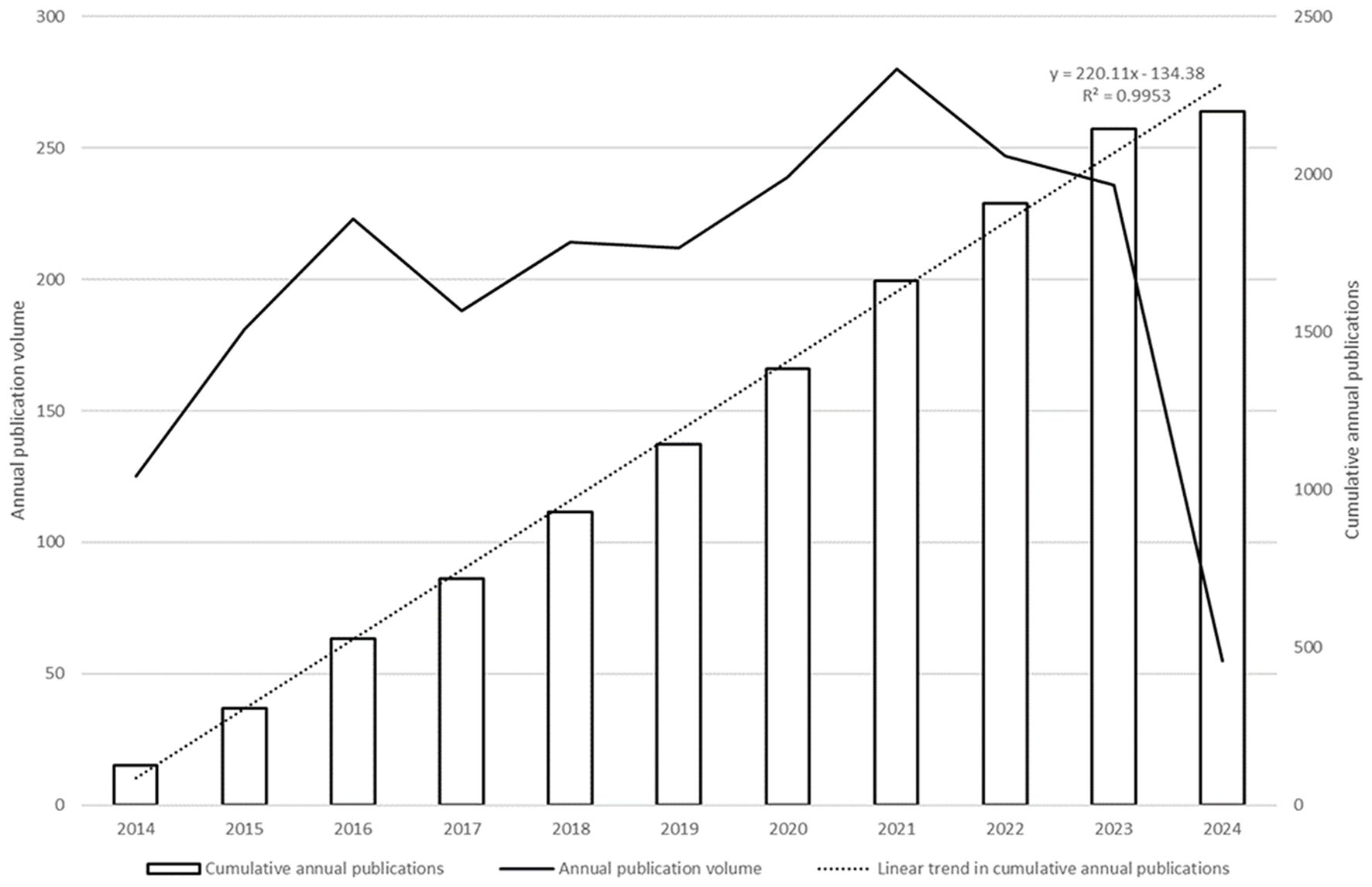
Figure 2. Statistics of Publications in the Relevant Field Worldwide Over the Past Decade. Annual Publication Volume: This line represents the number of publications made each year over the past decade. Cumulative Annual Publications: This line shows the cumulative total of publications up to and including each year.
3.2 Contributions from countries and institutions
A total of 89 countries/regions and 420 institutions participated in these studies. Figure 3A illustrates the global distribution of research output and citations in the field of immunoregulatory mechanisms of allergic rhinitis. The size of the circles represents the number of publications, with larger circles indicating higher publication output. The color gradient of the circles indicates the number of citations, with darker colors representing higher citation counts. The map highlights significant contributions from China, the USA, and several European countries, showcasing their central role in global research collaboration. China (583 papers, 26.5%) and the United States (454 papers, 20.6%) were the major contributing countries, with other productive countries including Germany (257 papers, 11.7%), Italy (221 papers, 10.1%), and the United Kingdom (193 papers, 8.8%). Centrality score is an important indicator for quantitatively evaluating the importance of nodes in the network. In terms of centrality score, Norway (0.11), Ukraine (0.07), Australia (0.06), and Mexico (0.06) ranked at the top, indicating the significant role of these countries in international cooperation (Table 1).
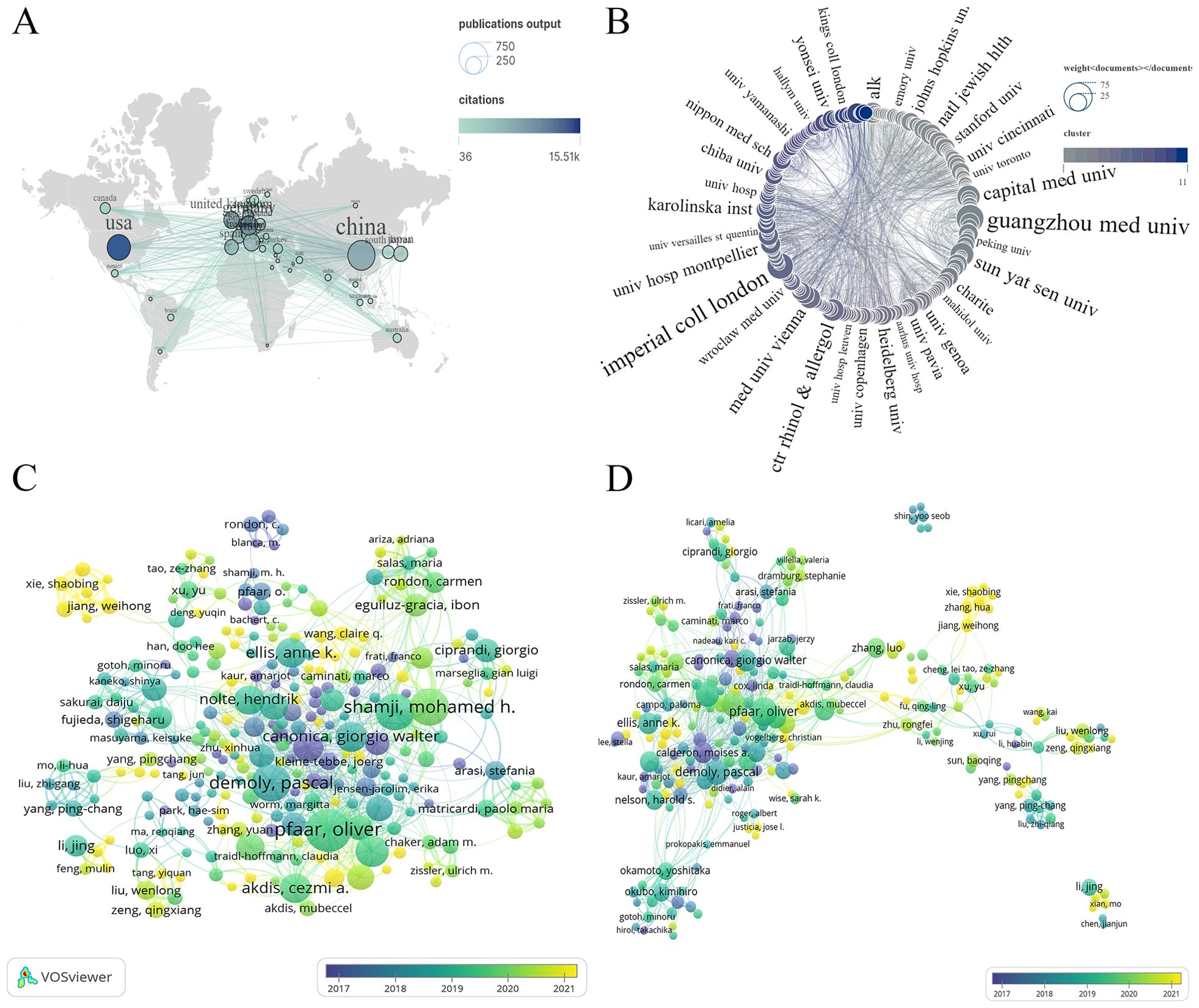
Figure 3. Global research output and collaboration in immunoregulatory mechanisms of allergic rhinitis. (A) Global distribution of publications and citations in immunoregulatory mechanisms of allergic rhinitis. (B) Institutional collaboration network. (C) Collaboration network of all authors with a production of ≥5 papers. (D) Collaboration network of the most prolific authors.
Figure 3B displays the collaboration between institutions in the field of immunoregulatory mechanisms of allergic rhinitis. The size of the circles represents the number of documents produced by each institution, while the lines connecting the circles indicate collaboration between institutions. Imperial College London, Guangzhou Medical University, and Center for Rhinology are shown as major hubs with extensive collaborative networks, indicating their significant roles in advancing research through partnerships. Imperial College London published 72 papers, making it the most contributing institution (Table 2). This was followed by Guangzhou Medical University (63 papers), Center for Rhinology and Allergology (55 papers), Capital Medical University (43 papers), and Sun Yat-Sen University (41 papers). In the collaborative network (Figure 3B), frequent cross-regional collaborations among many institutions were observed. The more connections with other institutions, the more collaborations are evident.
3.3 Authors and co-cited authors
A total of 10,309 authors contributed to this field, with a threshold of at least five published papers used to create the author collaboration network graph (Figure 3C). Oliver Pfaar from the Rhinology and Allergology Center in Germany was the most prolific scholar with 54 published papers and the highest number of collaborations in research, demonstrating his extensive academic influence and collaborative spirit (Figure 3D). This was followed by Stephen R. Durham (34 papers) and Mohamed H. Shamji (33 papers) from Imperial College London in the UK, and Pascal Demoly (33 papers). In terms of citation counts, Oliver Pfaar’s research was cited 2213 times, while Cezmi A. Akdis and Stephen R. Durham were cited 2102 and 1700 times, respectively (Tables 3, 4).
3.4 Journals and co-cited journals
Among the selected 2200 papers, they were published across 522 academic journals. The top 10 most productive journals collectively published 584 papers, accounting for 26.55% of the total (Table 5). Among them, “Allergy” (115 papers) and the “Journal of Allergy and Clinical Immunology” (82 papers) stand out as the most influential journals, cited 12,327 and 17,721 times, respectively, underscoring their pivotal role in allergic disease research.
From Table 5, it is observed that among the top 10 journals with the most citations, all have been cited over 1000 times. Specifically, two journals have exceeded 10,000 citations each: the “Journal of Allergy and Clinical Immunology” (17,721 citations) and “Allergy” (12,327 citations). The journal with the highest impact factor is the “New England Journal of Medicine” (IF = 158.5), followed by the “Journal of Allergy and Clinical Immunology” (IF = 14.2). Selecting journals with a minimum citation count of 200, a co-citation network was constructed as depicted in Figures 4A, B.
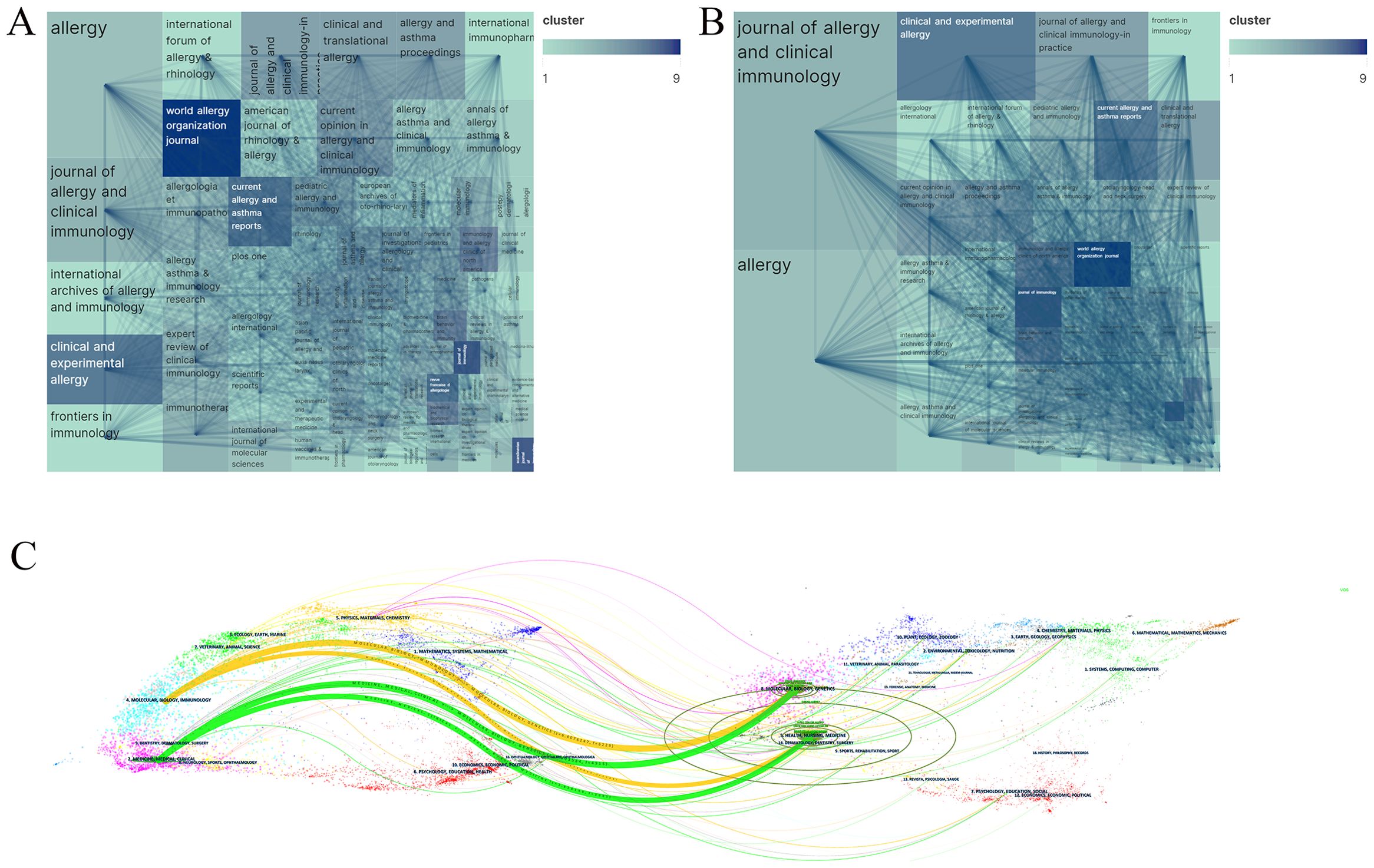
Figure 4. Journal output and collaboration network. (A) Explain the output and collaboration status of academic journals. (B) Analyze journal citations. The threshold for selection is set as journals with a cumulative citation count ≥200. (C) A dual-map overlay analysis of journals.
The overlay of dual maps of journals illustrates the thematic distribution of relationships between journals (Figure 4C). On the left side of the map are the citing journals, while on the right are the cited journals. Within the map, four main citation paths reveal the reciprocal influence and mutual progress between molecular biology, immunology, and clinical medicine. They indicate that without advancements in the knowledge structures of molecular biology and immunology, the development of allergy-related clinical medicine would be challenging. Conversely, without the validation and feedback from clinical medicine, the fields of molecular biology and immunology would struggle to move forward. This interdisciplinary field primarily encompasses disciplines such as medicine, molecular biology, and immunology.
3.5 Keywords co-occurrence and burst analysis
The co-occurrence analysis of keywords reveals a total of 7064 extracted keywords, with 184 keywords appearing more than 20 times. The Figure 5A illustrates the keyword co-occurrence analysis, revealing the evolving focus of research on the immunoregulatory mechanisms of allergic rhinitis from 2014 to 2024. Major topics such as “asthma” (825 occurrences), “allergic rhinitis” (793 occurrences), “sublingual immunotherapy” (448 occurrences), “rhinitis” (426 occurrences), and “immunotherapy” (393 occurrences) have consistently garnered significant interest. In the earlier years, research emphasized respiratory allergy, randomized controlled trials, prevalence, efficacy, subcutaneous immunotherapy, expression, and response. Since 2018, there has been a notable shift towards NF-kappa B, pathways, macrophages, proteins, regulatory B cells, allergen challenges, and air pollution (Figure 5A).
Clustering analysis of keywords helps identify the structural framework of a relevant research field. Each cluster represents a distinct research theme, with the size of the nodes indicating the frequency of keyword occurrences. By selecting the top 10 clusters based on the strength of keyword co-occurrence links, different-colored circles represent the appearance of years (Figure 5B). A timeline view based on the co-occurrence of keywords aids in visualizing phased research hotspots and directions over time (Figure 5C). Over the past decade, research directions have focused on specific immunotherapy, intralymphatic immunotherapy, sublingual and subcutaneous immunotherapy, regulatory T cells, chronic rhinosinusitis, immune response, immune system, and risk factors. The depth of color in this area indicates that keywords are distributed sequentially over time.
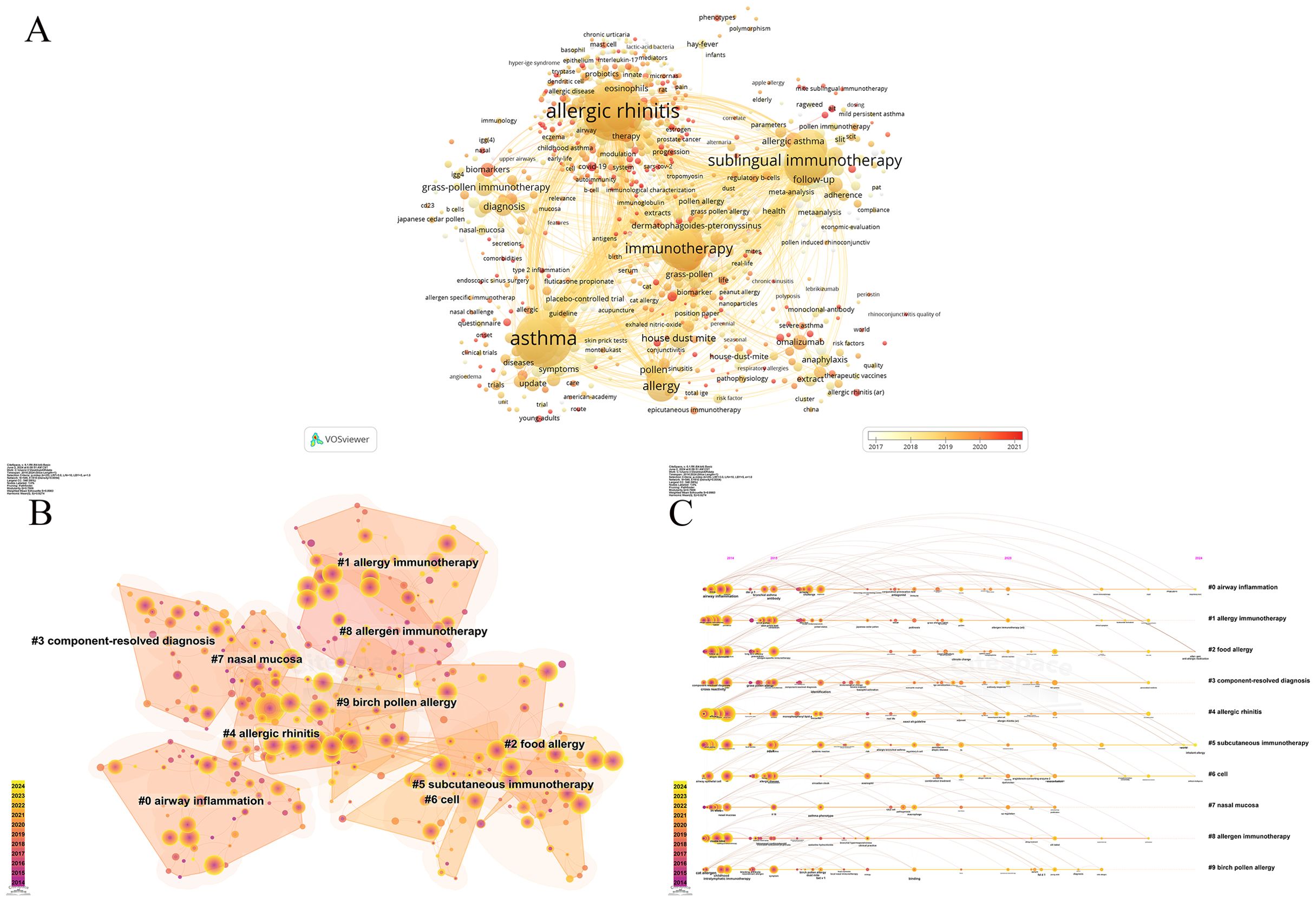
Figure 5. Keyword analysis and research clusters in allergic rhinitis immunoregulation. (A) keyword co-occurrence analysis. (B) Keyword clustering analysis. (C) Keyword co-occurrence timeline.
Keyword bursts elucidate trends in the development of this field. Figure 6 displays the top 25 keywords with the strongest bursts. From 2014 to 2024, “respiratory allergy” had the highest burst strength (8.38), followed by “randomized controlled trial” (7.18) and “prevalence” (6.85). Additionally, “NF kappa B” and “prevalence” maintained burst strength until the publication year of 2024, reflecting the latest research trends.
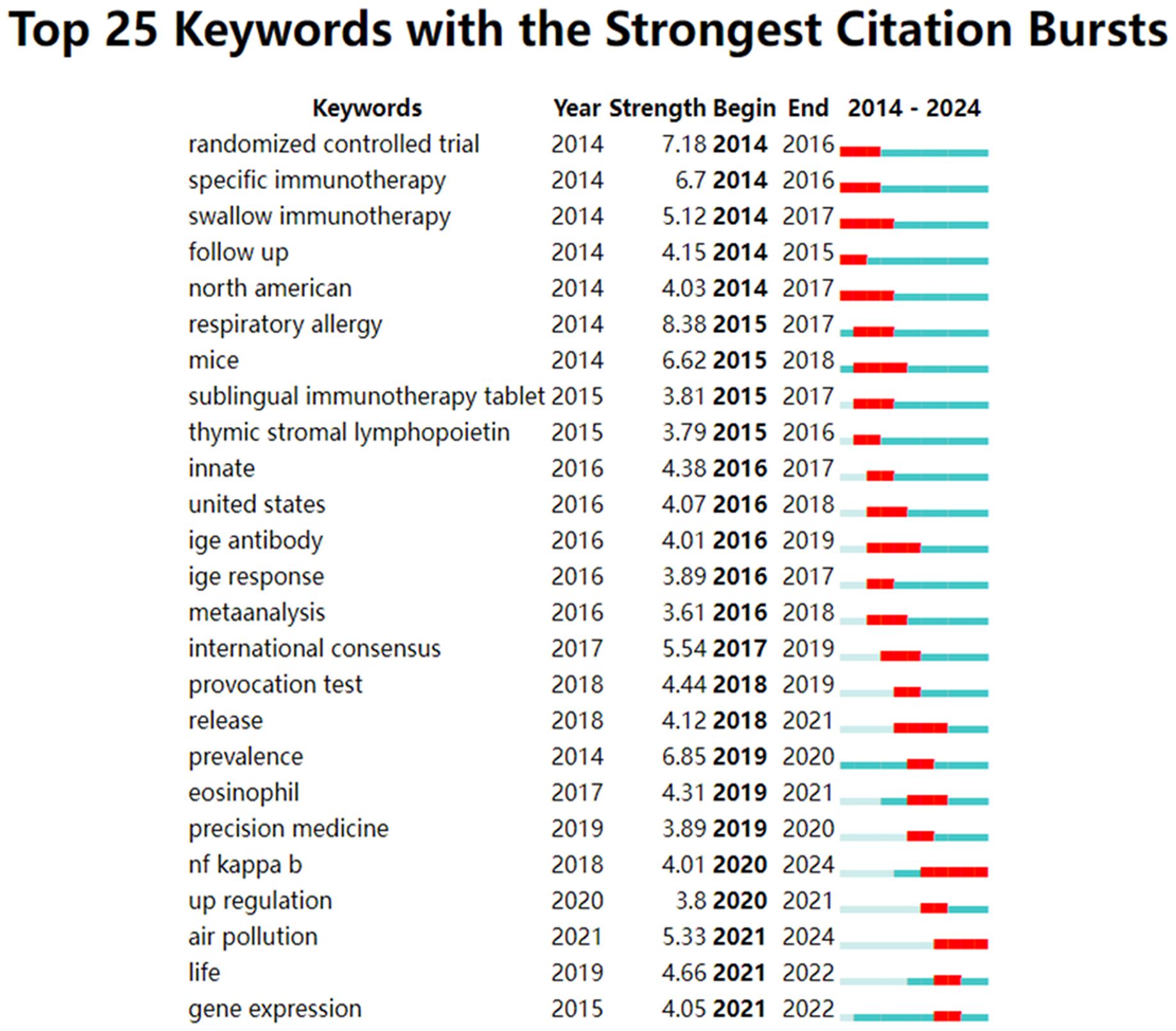
Figure 6. The top 25 keywords with the strongest citation bursts related to the immunoregulatory mechanism of allergic rhinitis.
3.6 Cited references and citation burst analysis
Cited references refer to documents cited by one or more publications simultaneously, representing the knowledge base of a specific field. The article by Bousquet et al., published in “Allergy” in 2008, has the highest number of citations (397), followed by the works of Cox et al., published in the “Journal of Allergy and Clinical Immunology” in 2011 (238 citations), and Brozek et al., published in the same journal in 2017 (178 citations) (Table 6).
Detecting citation bursts in referenced literature can indicate the evolution of hotspots over time and future trends in a particular field. Figure 7 displays the top 25 referenced documents with the strongest citation bursts. Among them, the 2017 publication by Brozek JL et al. in “J Allergy Clin Immun” titled “Allergic Rhinitis and its Impact on Asthma (ARIA) guidelines—2016 revision” exhibits the strongest citation burst. Additionally, papers including “Next-generation Allergic Rhinitis and Its Impact on Asthma (ARIA) guidelines for allergic rhinitis based on Grading of Recommendations Assessment Development and Evaluation (GRADE) and real-world evidence,” “Allergen Immunotherapy in Children User’s Guide,” “Allergic rhinitis,” and two sets of “EAACI Guidelines on Allergen Immunotherapy” have sustained citation bursts until 2024.
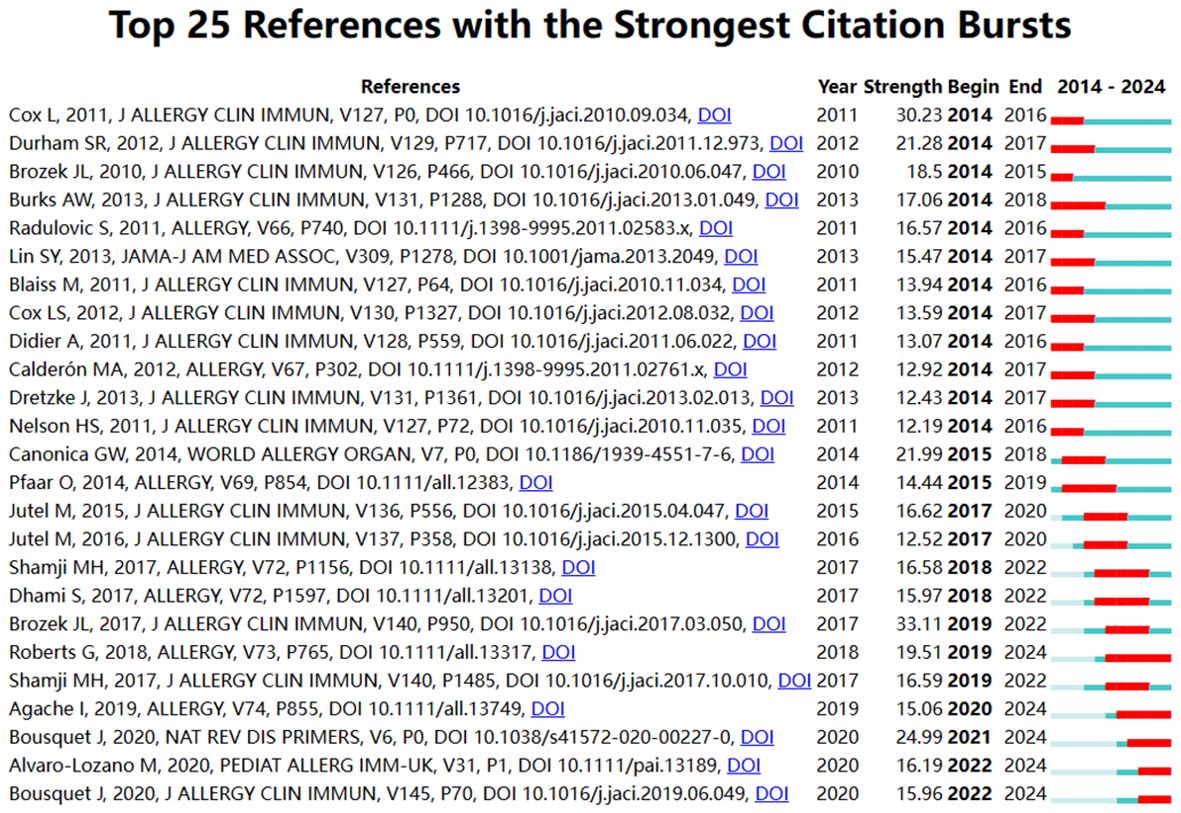
Figure 7. The top 25 cited articles with the strongest citation bursts related to the immunoregulatory mechanism of allergic rhinitis.
Figure 8 illustrates the co-citation network of references in the research on immunoregulatory mechanisms of allergic rhinitis from 2014 to 2024. This cited reference network consists of 854 nodes and 1056 links. Each node represents a cited reference, and the size of the node indicates the number of citations. The lines connecting nodes represent co-citation relationships. Prominent references, such as those by Canonica GW (2014), Brozek JL (2010, 2017), and Pfaar O (2014), are highlighted due to their high citation counts and central roles in the network. The color gradient from purple (2014) to yellow (2024) shows the timeline, indicating how the focus of citations has shifted over time. This analysis helps identify influential studies and emerging trends in the field.
In-depth analysis reveals that these documents represent 24 major research directions in the field, with the most significant ones being “experts perspective” (#0), “lymphoid cell” (#1), “care pathway” (#2), “future trend” (#3), “toll-like receptor” (#4), “local allergic rhinitis” (#5), and “food allergy” (#6). The recent ongoing directions include “experts perspective” (#0) and “inhalant allergy” (#22) (Figure 9A). The main research areas are concentrated in “respiratory system” (#0), “pediatrics” (#1), “otorhinolaryngology” (#2), “surgery” (#3), “economics” (#4), “pharmacology & pharmacy” (#5), and “cell biology” (#6). Currently, “respiratory system” (#0) and “genetics & heredity” (#22) remain important research areas (Figure 9B).
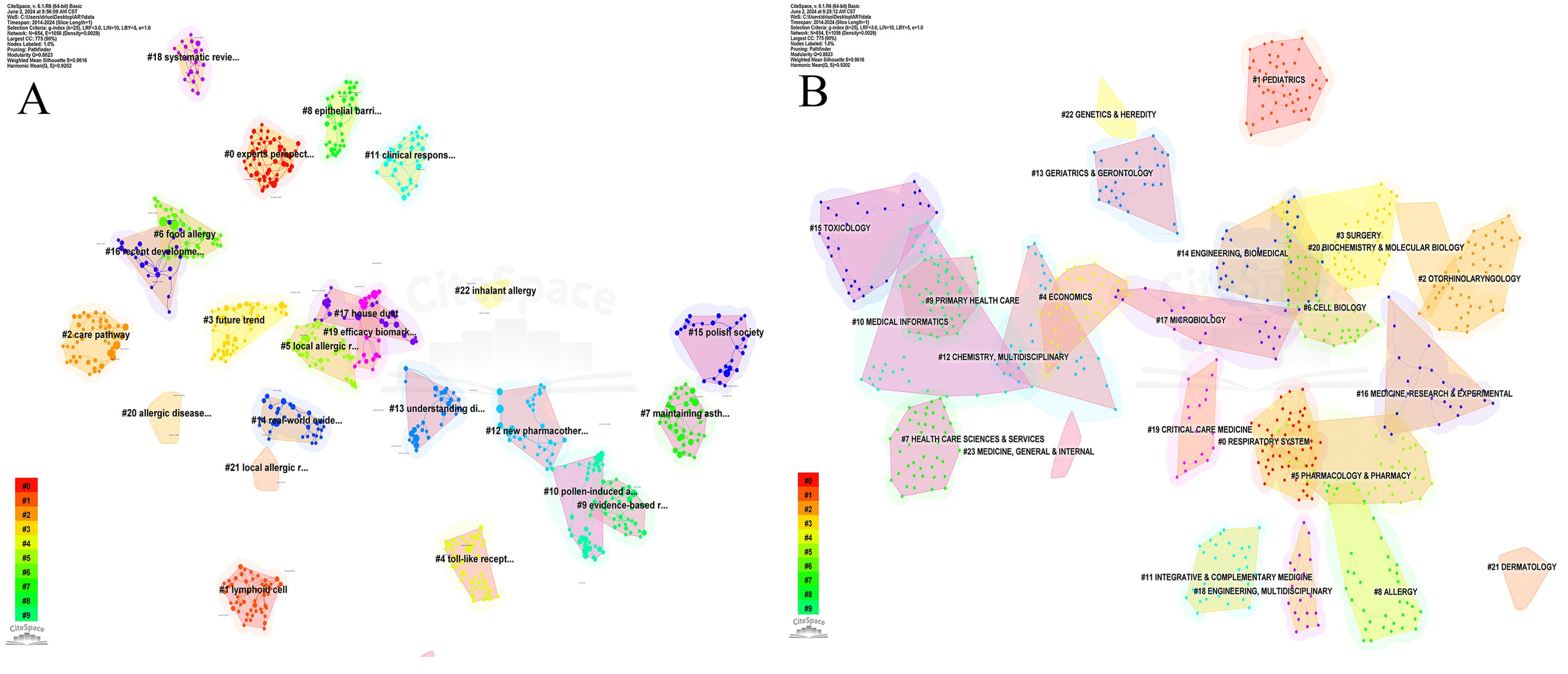
Figure 9. Clustering analysis of co-cited references. (A) Clustering analysis of research directions. (B) Clustering analysis of research themes categories.
4 Discussion
4.1 General information
The publication trends in allergic rhinitis (AR) and immunoregulation over the past decade demonstrate a marked increase in research output, reflecting a growing global awareness of allergic diseases. Countries such as China and the United States are leading contributors, likely due to robust research funding and strategic prioritization of allergic disease studies. This increased focus has been crucial in addressing the rising prevalence of AR and other allergic conditions, which are influenced by environmental changes and lifestyle factors.
High-impact institutions, including Imperial College London and Guangzhou Medical University, have emerged as key players in this field. These institutions not only produce a significant volume of research but also influence the direction of studies through collaborative networks and partnerships with other leading entities. The concentration of prolific authors in these institutions further accentuates their role in advancing the field, as these researchers frequently collaborate across borders, enhancing the quality and reach of the research.
Advanced bibliometric tools such as VOSviewer have provided valuable insights into these collaborative networks, highlighting the interconnected nature of the research community. The mapping of co-authorship and institutional collaborations reveals a dense web of interactions that facilitate knowledge sharing and innovation. This network structure is particularly important in identifying and developing emerging research areas, such as personalized medicine in AR, which aims to tailor treatments based on individual patient profiles.
Overall, these findings underscore the importance of continued investment in research infrastructure and international cooperation. As allergic diseases continue to pose significant public health challenges, the research community must leverage these collaborative frameworks to explore new therapeutic avenues and improve patient outcomes. The future of AR research lies in fostering interdisciplinary collaboration and integrating new technologies to deepen our understanding of immunoregulatory mechanisms.
4.2 Implications for clinical practice and future research
These publications provide guidance for future research on AR, emphasizing the development of personalized treatment strategies, focusing on patient quality of life, enhancing the representativeness of clinical trials, and strengthening the generalizability of research. Research should continue to investigate the efficacy of AIT in treating allergic asthma and use the GRADE approach to develop treatment recommendations. Future research priorities also include exploring the impact of environmental exposure and genetic background on AR and the application of mobile technologies in personalized treatment.
For AIT treatment of allergic diseases in children, research should focus on clinical outcomes, immune mechanisms, indications, and routes of administration. Updates to the ARIA guidelines should consider the GRADE guidelines and real-world evidence to optimize drug treatment strategies and explore the application of molecular diagnostics and digital health systems in AIT management.
A keyword co-occurrence analysis reveals that the focus of research on the immunoregulatory mechanisms of allergic rhinitis has been gradually shifting. From 2014 to 2024, topics such as allergic rhinitis, asthma, sublingual immunotherapy, immunotherapy, and allergy have consistently been major points of interest for researchers. In the early part of this period, there was more emphasis on respiratory allergy, randomized controlled trials, prevalence, efficacy, subcutaneous immunotherapy, expression, and response. Since 2018, there has been increased attention on NF-kappa B, pathways, macrophages, proteins, regulatory B cells, allergen challenges, and air pollution. NF-kappa B and air pollution, in particular, continue to influence current research, reflecting the latest trends in the field.
NF kappa B is an important protein complex that regulates inflammation, immune responses, cell proliferation, and apoptosis within cells (24). It is expressed in various cells and is crucial for maintaining cellular stability and responding to external stimuli (25). NF kappa B is inactive when bound to the inhibitory protein Ikappa B in the cytoplasm (26). Upon receiving inflammatory or stress signals, Ikappa B kinase activates and phosphorylates Ikappa B, leading to its ubiquitination and degradation, thereby releasing NF kappa B. NF kappa B then enters the nucleus, activating the transcription of genes encoding inflammatory mediators, which play a role in immunity and inflammation (27). NF kappa B is also a significant target in the treatment of autoimmune diseases (28), chronic inflammation (29), and cancer (30).
In AR, NF kappa B exacerbates symptoms by regulating inflammation and activating immune cells (31). It promotes the Th2 immune response and the production of inflammatory cytokines (32), making it a potential therapeutic target. Drugs such as corticosteroids can alleviate symptoms by inhibiting NF kappa B activity (33), offering new strategies for controlling AR inflammation. A deeper understanding of the role of NF kappa B in AR is crucial for developing future treatment strategies.
Air pollution is closely related to AR because harmful substances like particulate matter, nitrogen dioxide, and ozone can exacerbate symptoms, trigger inflammation, and cause immune imbalance, increasing sensitivity to allergens (34). During pollen season, the interaction between air pollutants and pollen can further worsen AR symptoms (35). Long-term exposure to polluted environments may also increase the risk of chronic inflammation and oxidative stress (36, 37), which are closely related to the development and exacerbation of AR. Effective mitigation of AR symptoms and improvement of treatment outcomes require reducing exposure to air pollution, necessitating joint efforts in public health policies and individual lifestyle changes.
Current research focuses on the specific mechanisms by which air pollution affects AR, including analyzing how pollutants activate inflammatory and immune responses through molecular pathways (38). Epidemiological and Geographic Information System (GIS) technology analyses examine how pollutants trigger inflammation and immune responses and their connection to AR incidence (39). Concurrently, clinical trials and intervention studies evaluate the effectiveness of reducing pollution exposure or medical interventions in improving AR symptoms (40). Personalized medical strategies are being explored based on individual genetics (41), lifestyle (9, 41, 42), and environmental exposure (43). Research on children with AR is also being strengthened to address their sensitivity to air pollutants (44). New technologies, such as remote sensing monitoring (45), the Internet of Things (IoT) (46), and mobile health technologies (47), provide new avenues for real-time air quality monitoring and assessing its impact on AR symptoms. Studies on policy and public health interventions are underway to reduce air pollution, improve the health of AR patients, and encourage interdisciplinary collaboration, combining environmental science (48), medicine (49), biology (50), epidemiology (51), and data science (52) to fully understand the relationship between air pollution and AR and develop more effective prevention and treatment strategies (35, 53).
Bibliometric analysis results provide guidance for clinical practice and future research in the AR field, revealing new therapeutic targets, such as the roles of NF kappa B and air pollution. Future research will be dedicated to developing personalized treatment plans (including genetic, environmental, and lifestyle factors) for precision medicine. Clinicians can benefit from understanding these emerging trends, incorporating the latest research into their treatment strategies, potentially improving patient outcomes. Future research should also focus on exploring different immune regulatory pathways in allergic diseases to find more effective treatment strategies. In the future, this field will integrate more secondary disciplines to study mechanisms related to immune regulation more precisely, ensuring personalized healthcare. Interdisciplinary collaboration and international cooperation will be key drivers of scientific progress in this field.
4.3 Limitations
Despite the comprehensive approach of this bibliometric analysis, several limitations should be noted. Firstly, the literature was exclusively extracted from the WoSCC database, which may result in an incomplete and biased inclusion of studies. Future studies should consider including multiple databases, such as PubMed, Scopus, and Google Scholar, to enhance the comprehensiveness of the data. Secondly, only English articles and reviews were included, which may exclude relevant research published in other languages and potentially lead to language bias.
Additionally, despite standardized procedures, certain biases may persist due to differences in keyword phrasing, identical author names, and continuous updates to the WoSCC database. Addressing these limitations in future research will enhance the accuracy and reliability of findings.
5 Conclusion
This bibliometric analysis highlights significant growth in research on the immunoregulatory mechanisms of allergic rhinitis over the past decade, with China and the United States as leading contributors and major research frontiers such as NF kappa B and air pollution. Developing personalized treatment plans and understanding environmental impacts are essential for advancing therapies. Interdisciplinary collaboration and international cooperation are crucial for further progress. These insights guide future research, emphasizing the importance of continued global and interdisciplinary efforts in enhancing allergic rhinitis treatment.
Data availability statement
The raw data supporting the conclusions of this article will be made available by the authors, without undue reservation.
Ethics statement
The studies involving humans were approved by the Ethics Committee of Huaihe Hospital of Henan University. The studies were conducted in accordance with the local legislation and institutional requirements. Written informed consent for participation was not required from the participants or the participants’ legal guardians/next of kin in accordance with the national legislation and institutional requirements.
Author contributions
YW: Data curation, Formal analysis, Investigation, Visualization, Writing – original draft. LZ: Investigation, Methodology, Validation, Writing – original draft. BS: Project administration, Supervision, Writing – review & editing. JL: Data curation, Resources, Software, Supervision, Writing – review & editing.
Funding
The author(s) declare financial support was received forthe research, authorship, and/or publication of this article. This work was supported by the following grants: Henan University Interdisciplinary Advanced Research Institute Construction Project (CX3070A0970005) Henan Provincial Medical Science and Technology Public Relations Program Provincial Ministerial Co-Construction Key Project (No: SBGJ202302093).
Conflict of interest
The authors declare that the research was conducted in the absence of any commercial or financial relationships that could be construed as a potential conflict of interest.
Publisher’s note
All claims expressed in this article are solely those of the authors and do not necessarily represent those of their affiliated organizations, or those of the publisher, the editors and the reviewers. Any product that may be evaluated in this article, or claim that may be made by its manufacturer, is not guaranteed or endorsed by the publisher.
References
1. Ma T, Wang X, Zhuang Y, Shi H, Ning H, Lan T, et al. Prevalence and risk factors for allergic rhinitis in adults and children living in different grassland regions of Inner Mongolia. Allergy. (2020) 75:234–9. doi: 10.1111/all.13941
2. Leth-Møller KB, Skaaby T, Linneberg A. Allergic rhinitis and allergic sensitisation are still increasing among Danish adults. Allergy. (2020) 75:660–8. doi: 10.1111/all.14046
3. Zhang Y, Lan F, Zhang L. Advances and highlights in allergic rhinitis. Allergy. (2021) 76:3383–9. doi: 10.1111/all.15044
4. Avdeeva KS, Reitsma S, Fokkens WJ. Direct and indirect costs of allergic and non-allergic rhinitis in the Netherlands. Allergy. (2020) 75:2993–6. doi: 10.1111/all.14457
5. Gould HJ, Sutton BJ. IgE in allergy and asthma today. Nat Rev Immunol. (2008) 8:205–17. doi: 10.1038/nri2273
6. Galli SJ, Tsai M, Piliponsky AM. The development of allergic inflammation. Nature. (2008) 454:445–54. doi: 10.1038/nature07204
7. Asher MI, Rutter CE, Bissell K, Chiang CY, El Sony A, Ellwood E, et al. Worldwide trends in the burden of asthma symptoms in school-aged children: Global Asthma Network Phase I cross-sectional study. Lancet. (2021) 398:1569–80. doi: 10.1016/S0140-6736(21)01450-1
8. Berings M, Karaaslan C, Altunbulakli C, Akdis M, Bachert C, Akdis CA, et al. Advances and highlights in allergen immunotherapy: On the way to sustained clinical and immunologic tolerance. J Allergy Clin Immunol. (2017) 140:1250–67. doi: 10.1016/j.jaci.2017.08.025
9. Bellinghausen I, Khatri R, Saloga J. Current strategies to modulate regulatory T cell activity in allergic inflammation. Front Immunol. (2022) 13:912529. doi: 10.3389/fimmu.2022.912529
10. Shamji MH, Durham SR. Mechanisms of allergen immunotherapy for inhaled allergens and predictive biomarkers. J Allergy Clin Immunol. (2017) 140:1485–98. doi: 10.1016/j.jaci.2017.10.010
11. Durham SR, Shamji MH. Allergen immunotherapy: past, present and future. Nat Rev Immunol. (2023) 23:317–28. doi: 10.1038/s41577-022-00786-1
12. Akdis CA, Akdis M. Advances in allergen immunotherapy: aiming for complete tolerance to allergens. Sci Transl Med. (2015) 7:280ps6. doi: 10.1126/scitranslmed.aaa7390
13. Bernstein JA, Bernstein JS, Makol R, Ward S. Allergic rhinitis: A review. JAMA. (2024) 331:866–77. doi: 10.1001/jama.2024.0530
14. Roberts G, Pfaar O, Akdis CA, Ansotegui IJ, Durham SR, Gerth van Wijk R, et al. EAACI guidelines on allergen immunotherapy: allergic rhinoconjunctivitis. Allergy. (2018) 73:765–98. doi: 10.1111/all.13317
15. Calderon MA, Casale TB, Nelson HS, Bacharier LB, Bansal P, Bernstein DI, et al. Extrapolating evidence-based medicine of AIT into clinical practice in the United States. J Allergy Clin Immunol Pract. (2023) 11:1100–15. doi: 10.1016/j.jaip.2022.10.033
16. Bousquet J, Schünemann HJ, Togias A, Bachert C, Erhola M, Hellings PW, et al. Next-generation Allergic Rhinitis and Its Impact on Asthma (ARIA) guidelines for allergic rhinitis based on Grading of Recommendations Assessment, Development and Evaluation (GRADE) and real-world evidence. J Allergy Clin Immunol. (2020) 145:70–80.e3. doi: 10.1016/j.jaci.2019.06.049
17. Farraia M, Paciência I, Castro Mendes F, Cavaleiro Rufo J, H Shamji M, Agache I, et al. Cost-effectiveness analysis of house dust mite allergen immunotherapy in children with allergic asthma. Allergy. (2022) 77:2688–98. doi: 10.1111/all.15321
18. Wise SK, Hamzavi-Abedi Y, Hannikainen PA, Anand MP, Pitt T, Savoure M, et al. Rhinitis disease burden and the impact of social determinants of health. J Allergy Clin Immunol Pract. (2024) 12(6):1449–61.e1. doi: 10.1016/j.jaip.2024.03.043
19. Chen CM. CiteSpace II: Detecting and visualizing emerging trends and transient patterns in scientific literature. J Am Soc Inf Sci Technol. (2006) 3):57. doi: 10.1002/asi.20317
20. Eck NJV, Waltman L. Visualizing Bibliometric Networks. Cham, Switzerland: Springer International Publishing (2014). doi: 10.1007/978-3-319-10377-8_13
21. van Eck NJ, Waltman L. Software survey: VOSviewer, a computer program for bibliometric mapping. Scientometrics. (2010) 84:523–38. doi: 10.1007/s11192-009-0146-3
22. Scimago ISG. SCImago journal & country rank: un nuevo portal, dos nuevos rankings. El Profesional la Informacion. (2007) 16:645–6. doi: 10.3145/epi.2007.nov.11
23. Pau LF. Excel 2019 for physical sciences statistics: a guide to solving practical problems, 2nd ed. (2023) Cham, Switzerland: Springer Cham.
24. Baltimore D. Discovering NF-kappaB. Cold Spring Harb Perspect Biol. (NY, USA: Cold Spring Harbor Laboratory Press) (2009) 1:a000026. doi: 10.1101/cshperspect.a000026
25. Zhang Q, Lenardo MJ, Baltimore D. 30 years of NF-κB: A blossoming of relevance to human pathobiology. CELL. (2017) 168:37–57. doi: 10.1016/j.cell.2016.12.012
26. Simeonidis S, Stauber D, Chen G, Hendrickson WA, Thanos D. Mechanisms by which IkappaB proteins control NF-kappaB activity. Proc Natl Acad Sci U.S.A. (1999) 96:49–54. doi: 10.1073/pnas.96.1.49
27. Weih F, Carrasco D, Durham SK, Barton DS, Rizzo CA, Ryseck RP, et al. Multiorgan inflammation and hematopoietic abnormalities in mice with a targeted disruption of RelB, a member of the NF-kappa B/Rel family. Cell. (1995) 80:331–40. doi: 10.1016/0092-8674(95)90416-6
29. Yang RC, Chen HW, Lu TS, Hsu C. Potential protective effect of NF-kappaB activity on the polymicrobial sepsis of rats preconditioning heat shock treatment. Clin Chim Acta. (2000) 302(1-2):11–22. doi: 10.1016/s0009-8981(00)00334-x
30. Spencer W, Kwon H, Crépieux P, Leclerc N, Lin R, Hiscott J. Taxol selectively blocks microtubule dependent NF-kappaB activation by phorbol ester via inhibition of IkappaBalpha phosphorylation and degradation. Oncogene. (1999) 18:495–505. doi: 10.1038/sj.onc.1202335
31. Kim SH, Park HH, Lee S, Jun CD, Choi BJ, Kim SY, et al. The anti-anaphylactic effect of the gall of Rhus javanica is mediated through inhibition of histamine release and inflammatory cytokine secretion. Int Immunopharmacol. (2005) 5:1820–9. doi: 10.1016/j.intimp.2005.06.007
32. Fan XL, Zeng QX, Li X, Li CL, Xu ZB, Deng XQ, et al. Induced pluripotent stem cell-derived mesenchymal stem cells activate quiescent T cells and elevate regulatory T cell response via NF-κB in allergic rhinitis patients. Stem Cell Res Ther. (2018) 9:170. doi: 10.1186/s13287-018-0896-z
33. Chen M, Xu S, Zhou P, He G, Jie Q, Wu Y. Desloratadine citrate disodium injection, a potent histamine H(1) receptor antagonist, inhibits chemokine production in ovalbumin-induced allergic rhinitis Guinea pig model and histamine-induced human nasal epithelial cells via inhibiting the ERK1/2 and NF-kappa B signal cascades. Eur J Pharmacol. (2015) 767:98–107. doi: 10.1016/j.ejphar.2015.10.014
34. Pacheco SE, Guidos-Fogelbach G, Annesi-Maesano I, Pawankar R, D' Amato G, Latour-Staffeld P, et al. Climate change and global issues in allergy and immunology. J Allergy Clin Immunol. (2021) 148:1366–77. doi: 10.1016/j.jaci.2021.10.011
35. D'Amato G, D'Amato M. Climate change, air pollution, pollen allergy and extreme atmospheric events. Curr Opin Pediatr. (2023) 35:356–61. doi: 10.1097/MOP.0000000000001237
36. Barbier E, Carpentier J, Simonin O, Gosset P, Platel A, Happillon M, et al. Oxidative stress and inflammation induced by air pollution-derived PM(2.5) persist in the lungs of mice after cessation of their sub-chronic exposure. Environ Int. (2023) 181:108248. doi: 10.1016/j.envint.2023.108248
37. Wiegman CH, Li F, Ryffel B, Chung KF. Oxidative stress in ozone-induced chronic lung inflammation and emphysema: A facet of chronic obstructive pulmonary disease. Front Immunol. (2020) 11:1957. doi: 10.3389/fimmu.2020.01957
38. Piao CH, Fan Y, Nguyen TV, Hawrylowicz CV, Pfeffer PE. PM(2.5) exacerbates oxidative stress and inflammatory response through the nrf2/NF-κB signaling pathway in OVA-induced allergic rhinitis mouse model. Int J Mol Sci. (2021) 22:8173. doi: 10.3390/ijms22158173
39. Glencross DA, Ho TR, Camiña N, et al. Air pollution and its effects on the immune system. Free Radic Biol Med. (2020) 151:56–68. doi: 10.1016/j.freeradbiomed.2020.01.179
40. Han X, Krempski JW, Nadeau K. Advances and novel developments in mechanisms of allergic inflammation. Allergy. (2020) 75:3100–11. doi: 10.1111/all.14632
41. Eaves LA, Harrington CE, Fry RC. Epigenetic responses to nonchemical stressors: potential molecular links to perinatal health outcomes. Curr Environ Health Rep. (2024) 11:145–57. doi: 10.1007/s40572-024-00435-w
42. Skypala IJ, Reese I, Durban R, Hunter H, Podesta M, Cury Chaddad MC, et al. Food allergy-A holistic approach to dietary management. A joint EAACI Research & Outreach Committee and INDANA review. Pediatr Allergy Immunol. (2023) 34:e14019. doi: 10.1111/pai.14019
43. Park JH, Moon JW, Yang HW, Song DJ, Park I-H. Effect of air pollutants on allergic inflammation in structural cells of the nasal mucosa. Clin Exp Otorhinolaryngol. (2024) 17:147–59. doi: 10.21053/ceo.2023.00079
44. Tsai YG, Chio CP, Yang KD, Lin CH, Yeh YP, Chang YJ, et al. Long-term PM(2.5) exposure is associated with asthma prevalence and exhaled nitric oxide levels in children. Pediatr Res. (2024). doi: 10.1038/s41390-023-02977-5
45. Kim J, Roh H, Moon S, Jeon C, Baek S, Cho W, et al. Wireless breathable face mask sensor for spatiotemporal 2D respiration profiling and respiratory diagnosis. Biomaterials. (2024) 309:122579. doi: 10.1016/j.biomaterials.2024.122579
46. Hwang J, Jo KS, Kim MS, Choi S, Lee J, Kim A, et al. Internet of things-enabled patch with built-in microsensors and wireless chip: real-time remote monitoring of patch treatment. Transl Vis Sci Technol. (2024) 13:18. doi: 10.1167/tvst.13.5.18
47. Kalasin S, Surareungchai W. Challenges of emerging wearable sensors for remote monitoring toward telemedicine healthcare. Anal Chem. (2023). doi: 10.1021/acs.analchem.2c02642
48. Sousa-Pinto B, Palamarchuk Y, Leemann L, Jankin S, Basagaña X, Ballester J, et al. From MASK-air and SILAM to CATALYSE (Climate action to advance heaLthY societies in Europe). J Investig Allergol Clin Immunol. (2024) 34:12–9. doi: 10.18176/jiaci.0923
49. Monos S, Yan F, McLean CC. Predicting adherence to topical medications in chronic rhinologic disease: A systematic review. Otolaryngol Head Neck Surg. (2024). doi: 10.1002/ohn.836
50. Li L, Huang F, Zhang YH, Cai Y-D. Identifying allergic-rhinitis-associated genes with random-walk-based method in PPI network. Comput Biol Med. (2024) 175:108495. doi: 10.1016/j.compbiomed.2024.108495
51. Jutel M, Klimek L, Richter H, Brüggenjürgen B, Vogelberg C. House dust mite SCIT reduces asthma risk and significantly improves long-term rhinitis and asthma control-A RWE study. Allergy. (2024) 79:1042–51. doi: 10.1111/all.16052
52. Ye F, Zhang H, Luo X, Wu T, Yang Q, Shi Z. Evaluating chatGPT's performance in answering questions about allergic rhinitis and chronic rhinosinusitis. Otolaryngol Head Neck Surg. (2024) 171:571–7. doi: 10.1002/ohn.832
Keywords: allergic rhinitis, immunoregulation, bibliometric analysis, NF kappa B, air pollution
Citation: Wang Y, Zhang L, Shi B and Luo J (2024) Trends and research foci in immunoregulatory mechanisms of allergic rhinitis: a bibliometric analysis (2014-2024). Front. Immunol. 15:1443954. doi: 10.3389/fimmu.2024.1443954
Received: 04 June 2024; Accepted: 09 September 2024;
Published: 24 September 2024.
Edited by:
Caterina Vizzardelli, Medical University of Vienna, AustriaReviewed by:
Rongfei Zhu, Huazhong University of Science and Technology, ChinaOlga Lourenço, University of Beira Interior, Portugal
Copyright © 2024 Wang, Zhang, Shi and Luo. This is an open-access article distributed under the terms of the Creative Commons Attribution License (CC BY). The use, distribution or reproduction in other forums is permitted, provided the original author(s) and the copyright owner(s) are credited and that the original publication in this journal is cited, in accordance with accepted academic practice. No use, distribution or reproduction is permitted which does not comply with these terms.
*Correspondence: Junpeng Luo, aGljY3BAaGVudS5lZHUuY24=
 Yandan Wang
Yandan Wang Liangran Zhang1
Liangran Zhang1 Junpeng Luo
Junpeng Luo